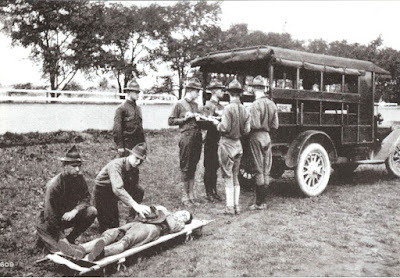As part of our ongoing but extremely occasional series on
cats in military insignia, today we bring you the story of a group of young men
from Amherst, Massachusetts, who volunteered as ambulance drivers for
the French army in the First World War. They came to be known as the Black
Cats, after the distinctive symbol they chose: a black cat in full-on scary pose,
with its back arched and tail pointing straight up. This symbol may have been
selected for good luck, writes amateur historian Jim Hamilton. Although in much
of the US today, the common superstition is that black cats bring bad luck, let us not forget that cats of all sorts of colors have been credited with (or blamed for) bringing all sorts of luck in different places and times.
 |
| The black cat symbol of SSU 539. Used with permission. |
So, what kind of luck did the Amherst Black Cats have? Let’s
find out…but first we must thank Jim Hamilton, who runs the Amherst Black Cats Twitter account and
graciously agreed to tell us a little more about the history of this unit. It
was through this Twitter account that we first learned of these young men from
Amherst.
The Black Cats answer the call
The group that would become known as the Black Cats got its
start on June 6, 1917, when several students and recent graduates of Amherst
College, as well as a few others, signed on to drive ambulances for the French
army. That summer, the unit headed to Allentown, Pennsylvania, to train at Camp
Crane, which was actually on the site of the Allentown Fairgrounds. A photo
recently posted on the Black Cats’ Twitter account shows that their barracks
was the Bantams and Pigeons building. Their training included driving lessons and medical
procedures. On August 6, they boarded the SS San Jacinto for the crossing to Europe, arriving at St. Nazaire,
France, just over two weeks later, on August 21.
 |
| The entrance to Camp Crane, 1918. The Amherst volunteers arrived here in summer 1917. US Army photo. Public domain, via Wikimedia Commons. |
The Black Cats on the Western Front
Officially known as Section Sanitaire États-Unis 539, or SSU
539, the Black Cats were sent to the war’s Western Front. They served with four
French army groups:
- The 47th Chasseurs Alpins
- The 27th Division Infantry (briefly)
- The 5th Division
- The 4th Army (briefly)
Driving
Ford Model T ambulances with their unit’s emblem on the side, the Black Cats participated
in three major offensives in 1918:
- the Aisne-Marne Offensive
- the Oise-Aisne Offensive
- the Ypres-Lys Offensive
They
also participated in a few minor operations. For their actions in evacuating
the wounded, often in difficult conditions, the Black Cats were awarded the
Croix de Guerre and were also entitled to wear the Fourragère.
Regarding
luck, theirs seems to have been good. In the course of their service, only one
member of the Black Cats was wounded and three were gassed. They all recovered.
One member of the unit said this in a letter home:
We are the original horseshoe section, if there ever was one. Think of having been in a year with only one man slightly wounded! I think it’s the black cat on our cars, although that didn’t prevent a shell from ruining Riefler’s car, just after he was safe in a dug-out. I know it takes a lot of narrow escapes to get a man, but we’ve had an unusual number of them, every one of us.
 |
| Ambulance Corps training (not SSU 539) at Camp Crane, Allentown, PA, 1918. Photo by unknown USAAS photographer. Public domain, via Wikimedia Commons. |
The Black Cats after
the war
Following
the Armistice that was signed on November 11, 1918, the Black Cats were
stationed in Belgium and Germany before sailing for home in March 1919. They
arrived back in the US on April 2. On April 23, a group of them marched from
the Amherst train station to the college and presented the unit’s flag to the
college president. The following year, they published a unit history (Amherst
has two copies of it in their archive), and going forward, they maintained a
chain letter of news updates for another ten years or so. College reunions
provided an opportunity for the men to meet up in person.
Now,
a century later, the Black Cats’ history continues to be written, as Jim Hamilton
is finishing an early draft of a book that he plans to publish later this year.
He will also be participating in a
panel called “Amherst at War” at the reunion in May of this year. The Black Cat
banner, which resides in the Amherst College archive, is in delicate condition,
and he is hoping that it will be restored, a process that may involve some
fundraising from alumni and Black Cat descendants.
Sources
Our main source, Jim Hamilton, is an amateur historian whose
books include “The Writing 69th,” the story of a group of war
correspondents, including Walter Cronkite and Andy Rooney, who covered the 8th
Air Force out of England during World War II. His current research is for a
book to be called “The Black Cats of Amherst,” which is about the World War I
ambulance unit that his grandfather served in. For more information on Jim and
his writing projects, please visit www.greenharbor.com.
Additional sources:
McFeely, William S. “The Black Cats of Amherst.” Amherst Magazine, Spring 2010. https://www.amherst.edu/amherst-story/magazine/issues/2010spring/blackcats


I'll have to see what Amherst has to memorialize them this summer. My daughter's family is only a couple of towns away and we've walked the campus before.
ReplyDeleteFascinating! The Great War was a horrible thing, and these young men went into it to help. A black cat as their symbol was a terrific idea.
ReplyDeleteThat was interesting. I'll have to check out the Twitter page.
ReplyDeleteThis is so interesting. I had not heard of these cats and I am only 30 minutes from Amherst.
ReplyDeleteI don't think I realized you lived down in that area, Ellen! I am originally from Easthampton.
DeleteJan, Wag 'n Woof Pets
Thanks for making us aware of this great story !
ReplyDeleteThis is so interesting!!! You always come up with the most fun historical cat-related topics! I'm off to follow them on Twitter now...
ReplyDeleteWoW! That was interesting! Thanks so much for sharing!
ReplyDeletePurrs
Marv
That is so interesting, especially since I used to live down in that area. I love how they credited their good luck to their black cat logo!
ReplyDelete